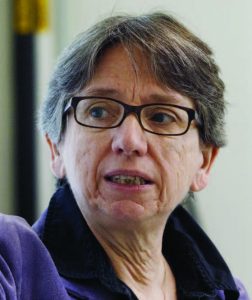
Terri HerrNeckar, Mathematics Department, 1996–2022

Terri HerrNeckar
By Gregg Reilly
Mathematics Department Faculty
With passion, integrity, creativity, clarity, and humor, Terri has committed herself to the education of young people for the past 37 years. An avid sports fan and keen-eyed photographer, Terri is a big picture thinker. She sets clear and high standards for students and colleagues. And, with compassion and kindness, Terri champions their cause in meeting them. That’s the right thing to do! That’s Terri’s way! Said another way (Terri will expect this), Terri is always looking to think outside the box, while simultaneously coloring between the lines.
Terri arrived at Milton in 1996 as the Mathematics Department was shifting away from traditional textbooks that had become both less relevant to and more expensive for our students. As Terri would say, “That’s just wrong!”. With her keen eye for detail and outstanding editing skills, Terri became a driving force behind the writing of curriculum that would provide our students with a more dynamic and responsive experience for more than two decades. Her trademark TJH can be found on countless documents used in myriad courses, many of which she hasn’t taught in over a decade. Most recently, she revamped our honors calculus curriculum, starting with integration which many feel is the more historically accurate development.
Terri is the consummate lifelong learner and a gifted teacher who knows that how each student learns best is a moving target. Thus, she is always on a quest for new ways like slide-decks, hyperdocs, pacing guides, and DESMOS investigations to provide her students easy access to the work at hand along with clear expectations and built in flexibility for its completion. Still, Terri finds a way to check-in with each student during class as she wanders among them engaging in short conversations (often involving laughter) to gauge where each is that day. She brought the same energy, clarity and compassion to her advisory, to the young men in Goodwin, to the DC, even to library duty, and in the past to the softball team and the SGA (where she helped them create our current ranked voting system).
Terri is also a dedicated colleague. With her innate ability to read people’s feelings, Terri has always looked to welcome and support new faculty. No surprise, she was the first holder of the Lee Chair. In recent years she has expanded that support in her roles on the Teaching and Learning Team and as a facilitator in Circle conversations. Many colleagues, myself included, have acknowledged that Terri has made us better teachers.
In her last class, Terri helped guide her Advanced Functions students through the concept of the secant line of a cubic function with a brief stop at the binomial theorem before helping them discover the tangent line (in point-slope form). At the end, she asked, “Isn’t that cool?” and they agreed! Actually Terri, you’re cool!
While Terri has given so much to Milton, she also found her beloved Elaine here and they have been cultivating a network of friends in Northampton where they will enjoy a calmer pace of life and continue their adventure together. Perhaps a burger and a beer at the Brewery, watching the Red Sox or a music session with Brick. You have both earned this next chapter and we wish you well.
Aside:
Before I read the Encomium proper, you should know that there is a hard maximum of 550 words, so in respect for Terri’s integrity to always do the right thing I could not fully elaborate on all of the contributions that Terri has had for our department, to the support and mentorship of numerous faculty members both young and old, and to her students, advisees, etc. Also, FYI, the brief math lesson I will talk about is actually really cool, ask Terri about it. Finally, John Banderob suggested that I use a prime number of words in it, there are 541.
Special thanks to Martha Jacobsen, Jeanne Jacobs, John Banderob, and Patrick Owens for their contributions to this work.




